Tiny Danish delight revisited
Author
- Mattijs Diepraam
Date
- July 16, 2008
Related articles
- Jack Brabham - The driver engineer, by Mattijs Diepraam
- Stirling Moss - How Stirling got his Mercedes breakthrough, by Mattijs Diepraam/Felix Muelas
Who?Jack Brabham, Graham Hill, Innes Ireland What?Cooper-Climax T51, Lotus-Climax 18, Lotus-Climax 18 Where?Roskilde Ring When?I Danish Grand Prix (September 10, 1960) |
 |
Why?
If these days you are heading for Roskilde at the end of June you are bound to be attracted by the colour and noise of the four-day rock festival which the old Danish town on the main island of Sealand is now internationally famous for. It was different in the sixties, when the noise was made by sportscars, touring cars, F3s, Juniors and even Grand Prix cars flashing across kerb-to-guardrail advertising painted across the surface of a tantalizing mini-track right outside the town’s centre. Visiting the location of the former Roskilde Ring today leaves you with a very different lasting impression on the audiovisual senses – that of peace and tranquility. We went for a walk in the park that was once Denmark’s most prominent speed bowl.
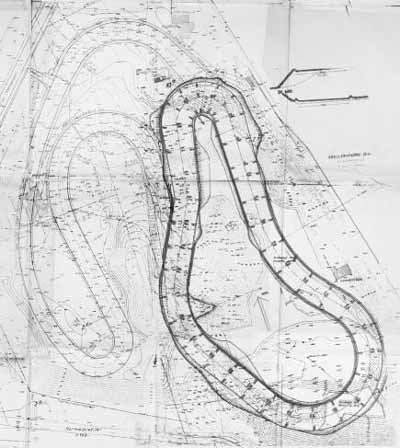
An original circuit map supplied to GPL programmers by the Roskilde Museum.
And a bowl it was, literally. Having started life as a gravel pit, the derilict site was transformed in the fifties to host a motor racing track that was called the Roskilde Ring. Its lay-out profited from the specifics of the terrain to create a small 0.67-km bean-shaped oval, using the steep walls of the abandoned pit to great effect to form its wide Pirelli curve with a banking of 11 degrees. Most other corners were banked too, even when the circuit was extended using a stretch of wasteland between the track’s Philips-Backen (formerly Lukoil) corner and the railroad to Copenhagen. The new west loop turned the circuit’s overhead appearance from a bean shape into a mouse shape, making the new 1.38km circuit a true Mickey Mouse track in every sense of the word...
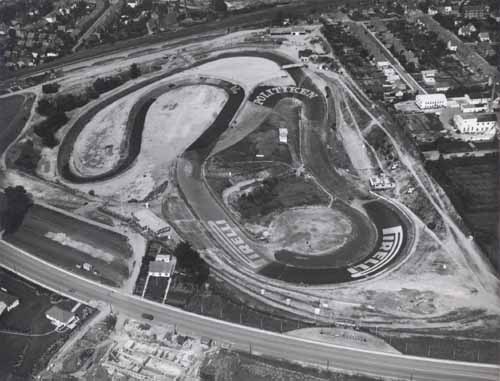
The new loop right after its construction.
Tiny it may have been, the elevation changes were markedly high, with almost 14m between the highest and lowest point on the circuit, while cars could go five abreast through the big Pirelli bend if they wanted to. The people watching the show were sitting even higher and were able to overlook the entire track – a spectator’s dream. You could easily make comparisons with rollercoaster rides and one-mile NASCAR ovals. The Roskilde Ring was an amphitheatre of Danish motorsport and the performing heroes had to steer all the way round – no straights, just corners. On a damp track that needed some quick reflexes since the white paint used for the huge on-track advertising signs for Pirelli, Danish magazine Politiken, Ford and Philips had some fairly interesting grip characteristics. Keeping it on the black stuff was an expression that was null and void at Roskilde Ring. And to make it even more awkward it was anti-clockwise, making it tough on the muscles.

The track in its heyday.
When it was opened on June 5, 1955, it was also Denmark’s first permanent motor racing circuit, and a creation of local businessman Poul Tholstrup. Its organiser, the Automobil Sport Klubben København (ASK), staged several sportscar races every year but the track really started to make a name for itself when it started offering big purses to foreign stars to come and race in the Danish Grand Prix. It is said that Stirling Moss was lured to Roskilde by the promise of a DKK 10,000 cheque, which in those days was an astronomical sum of money. It’s no wonder that the Danish starting money caused privateers such as Wolfgang Seidel, Ian Burgess and Carel Godin de Beaufort to make the trip to Scandinavia. In fact, the Danish Grand Prix was part of a twin Nordic summer adventure also comprising the Kanonloppet race at Karlskoga, usually run one or two weeks later, and many travelled on to Helsingør to take the boat to Sweden and collect even more starting money.
The years in which the Danish Grand Prix was open to Grand Prix cars formed the undoubted highlights in the brief history of the Roskilde Ring. It was preceded by an infamous four-heat Grand Prix for F2 cars on September 10, 1960, witnessed by a crowd of 50,000. Sadly, the first heat took the life of promising Kiwi George Lawton, at the time considered a prospect more talented than his future-World Champion team mate Denny Hulme. That wasn’t Roskilde’s only fatality, however. In 1965, touring car driver Pelle Ancher died during one of the Ring’s Copenhagen Cup touring car races, while a photographer was among the spectator casualties.
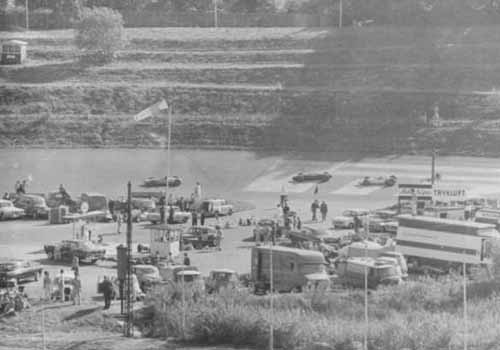
A view on the paddock area with the Pirelli curve acting as its imposing backdrop.
When F2 became F1 the following year, the Danske Grand Prix (mistakenly described in Sheldon’s Black Book as ‘Grote Prijs van Danske’, a strange combination of Dutch and Danish) unsurprisingly followed suit, joining the hordes of minor events hosting a Formula 1 race. Because of the track length – or rather its shortness – events were almost always split up in two qualifying heats, sometimes with a final. In fact, the 1961 F1 race was held in three heats, the first being 20 laps long while the second and third were run over 30 laps. Aggregate winner Moss wrapped them up in less than an hour in total… A year later, winner Jack Brabham (who also won the three heats) lowered the F1 track record to 42.7 seconds, which was quite phenomenal since that was 4.3s faster that Moss’s 1961 lap record and seven tenths under his own qualifying time.
It wouldn’t remain the track’s outright lap record, however. By the late sixties, F3 cars had become as quick as the former 1.5-litre F1 cars and in 1967 Kurt Ahrens lowered Brabham’s record to 42.5s, averaging 73.687mph. A year later Sweden’s Jean Johansson took off a tenth before Reine Wisell lopped off another four tenths in the final race at the Roskilde Ring, one month later, putting it at 42.0s, which translates into an average of exactly 120.000kph (74.565mph).



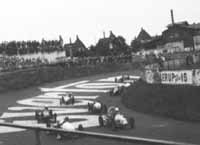
The circuit hosted events for sportscars, touring cars and Juniors alike.
That swansong race, the Scalextric-Løbet F3 race won by Wisell in a Team Baltsar Tecno-Ford 68, was held on the day I was born – September 22, 1968. During the sixties, Roskilde had grown further to the South, and a new residential area had formed beyond the railway tracks and the circuit was soon enclosed by housing estates. The number of noise complaints increased by the year and the track was finally closed in 1969.
Track owner ASK made a small fortune out of selling the grounds and starting looking for a new site near Copenhagen to replace the Roskilde Ring. First they looked in the area of Hillerød, the town of the impressive former royal palace of Frederiksborg, before being given the green light to build a circuit near Regstrup and Nørre Jernløse, some 40km west of Copenhagen. But those plans fell through and after that the authorities refused permission for yet another location in the vicinity of Copenhagen. Even today, all of Denmark’s permanent circuits – Jyllandsringen, Ring Djursland and the recently opened Padborg Park near the German border – are situated on the Danish mainland peninsula of Jutland.

A plan of the circuit.
Looking for the Roskilde Ring today is not very difficult. The site is easy to spot on any satellite picture of the town, and the surrounding roads are still the same. After its closure it was turned into a park, and although the last bit of tarmac was removed over 30 years ago you can still bear out the shape of the entire track.
While the control tower building was demolished without a trace, a hotel is situated on the exact spot of the former restaurant near the West entry to the circuit. The park now contains a 9-hole golf course, but not of the usual sort. Instead, visitors are tempted to try their hands at a game called disc golf, which entails throwing a frisbee into a basket some 50 to 100 yards up ahead in as few attempts as possible. It’s unknown what is considered par for the course but we do know that some descriptions of today’s Roskilde Ring park should speak about a 9-basket frisbee course instead of a golf course. In fact, it seems that disc golf is a proper sport of itself, with pictures of the 2008 Roskilde Ring Open seen here!
I visited the Roskilde Ring park in early July 2008, on the final day of the Roskilde Festival. This meant that the town was almost empty. Most of the shops in the city centre were closed and the only people in the street were hippies taking a break from the festival and tourists visiting the famous Roskilde cathedral, known as the burial site for Danish royals. Most other tourists were at the Viking ship museum in the harbour area. The park is situated a few blocks south from the town centre and is lined by the Odense-Copenhagen railroad, the Sønder Ringsvej and a residential area.
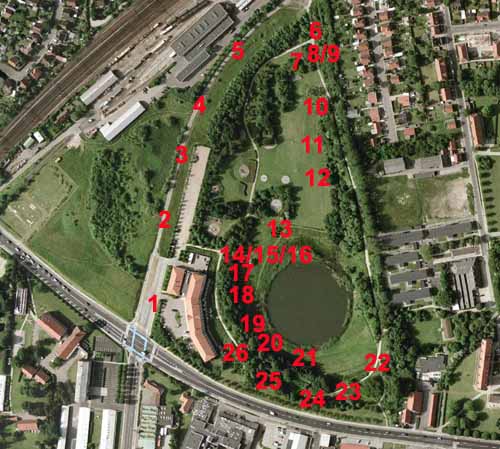
An aerial view of the park today. It’s easy to spot the hotel, the railroad and the Sønder Ringsvej. The numbers correspond with the vantage points of the pictures below.
When I circumnavigated the park it was eerily silent. There was just the wind, the birds and some couples snogging in the grass wondering what that guy was doing making pictures of trees and an insignificant sign at the top of the hill in the top right-hand corner of the circuit where a sharp left-hander called the Ford corner announced the start of the new loop. Then the sounds blowing over from the Roskilde Festival site – straight on from the city, passing the park – swelled again, the start of a new song greeted with massive cheers from the crowd.
The Scandic Hotel’s parking lot is the obvious starting point for a tour of the ‘circuit’. From there you can start exploring the new-loop area by walking the North-bound bicycle path west of the park, although admittedly there is absolutely nothing to see. Most of the new loop’s back stretch has been built over when the railway extended their cargo area, while the Bosch curve’s shape is only recognizable from the air. As for the rest, it‘s back to the wasteland it once was.
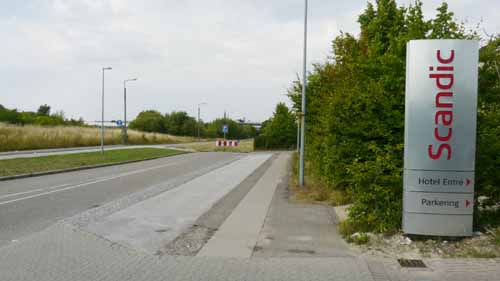
1. The bicycle path cuts across the old circuit, splitting the former new loop from the initial 1955 track.
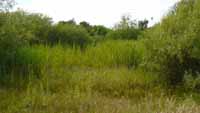
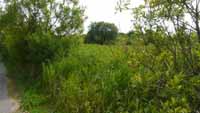
2/3. The new-loop area is now totally covered in weeds.
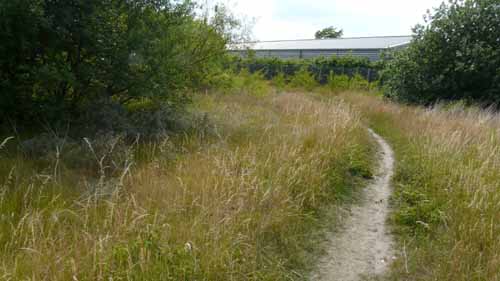
4. This small path cuts across to the former Bosch curve.
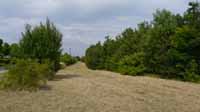
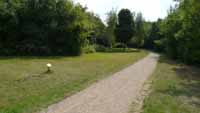
5/6. It's tempting to attribute these curving shapes in the landscape to the former track’s course, but in these cases that would be wrong.
Then turn right at the point where the bicycle path changes direction towards the town centre and make your way through the trees.
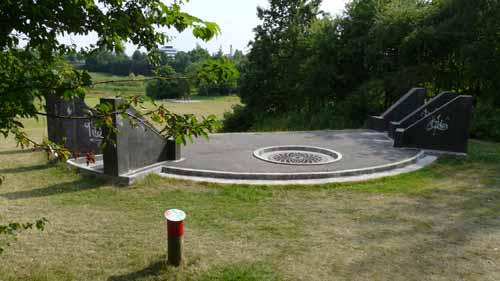
7. This monument stands atop the hill where the Politiken cut-off went left.
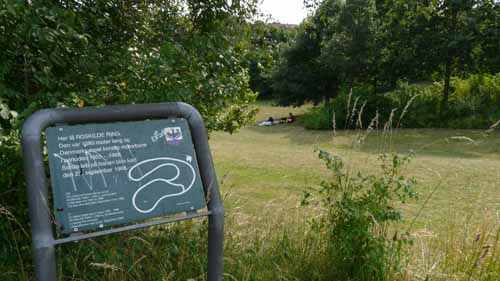
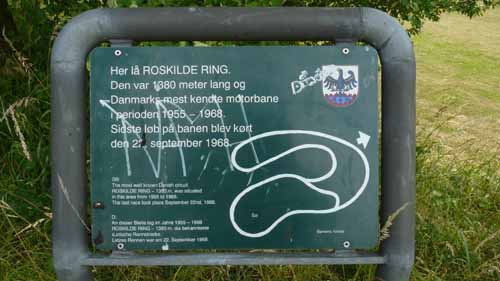
8/9. A small sign on the former entry of Politiken is the only thing commemorating the park’s former identity.
Suddenly the entire bean shape of the original 0.67km circuit unfolds itself, viewed from the Politiken left-hander. The initial knick in this later cut-off section is still visible as the grass and trees are closely following the track lay-out as it was.
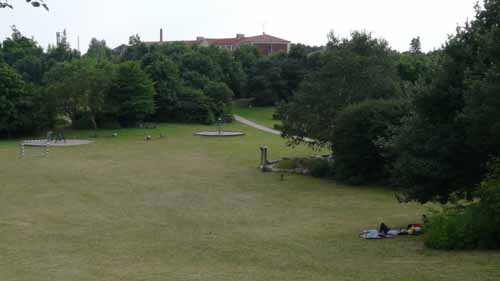
10. A view from Politiken on the Philips-Backen.
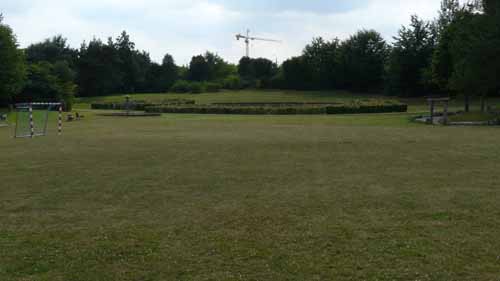
11. Philips-Backen's slope seen from the start-and-finish 'straight'.
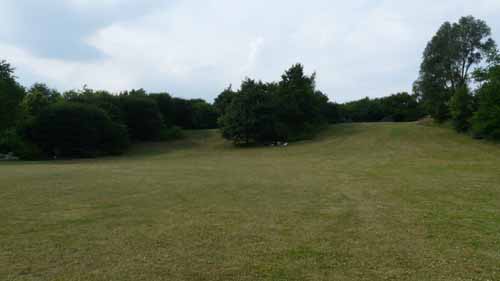
12. A good view of the Politiken cut-off: the main track headed into the opening on the right, the cut-off would be on top of the hill, turning back sharply before the track plunged down again out of the second opening in the middle of the picture.
From there it’s an easy stroll across the center area to the other side of the former track, going right past the circular former paddock area, now turned into a pond. Behind it, the daunting Pirelli corner hoves into view.
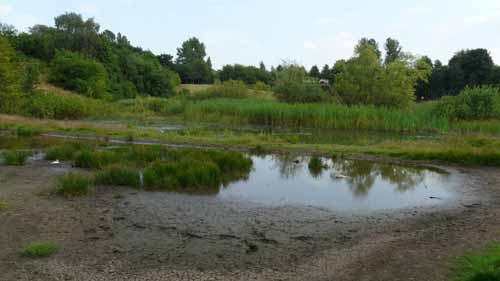
13. The paddock is now the park's central pond.
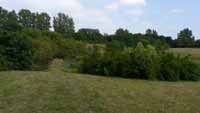
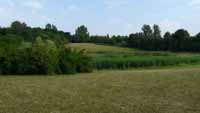
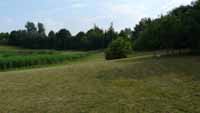
14/15/16. Three pictures forming a panorama of the Pirelli corner, seen from a spot between the pond and the former Philips-Backen.
From here, you are able to walk almost the entire Pirelli corner. Looking up to the hotel, way up high above where once the spectators sat, hugging their amphitheatre-style grandstands, it’s not hard to be impressed by the steepness of the banking.
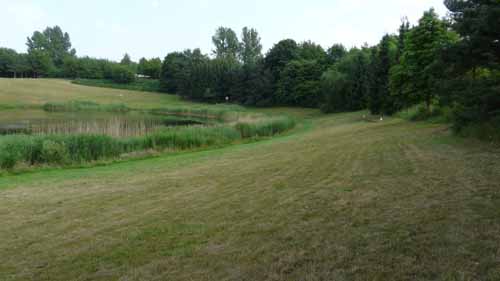
17. The full scale of the Pirelli corner.
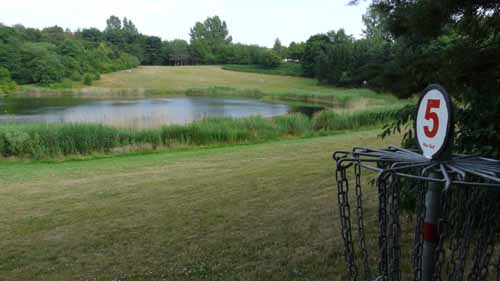
18. Disc golf baskets are seen everywhere along the Pirelli corner.
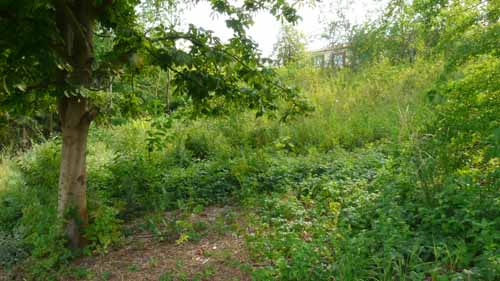
19. The hotel is way up from where you are.
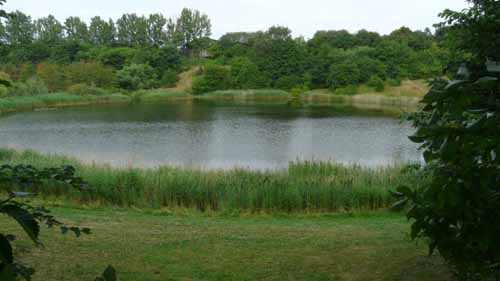
20. Here you will be able to appreciate the size of the center paddock area.
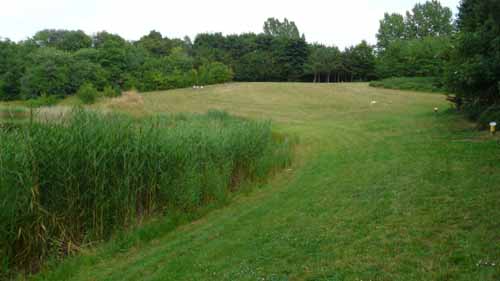
21. Approaching the end of Pirelli corner.
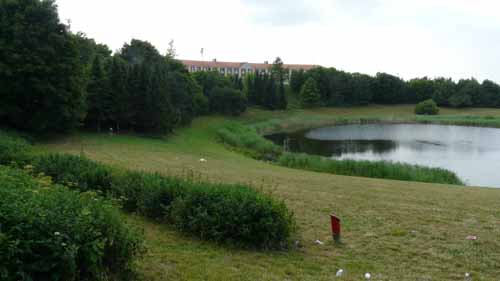
22. Pirelli corner with the hotel towering high above.
As you reach the end of the Pirelli corner you will get a good view of the entire track, erm, park as it is seen from the south. Here you are able to cut across the former spectator area as you climb back towards the Sønder Ringsvej. There is a footpath going from there to the hotel’s terraces, running along the top of the former grandstands.
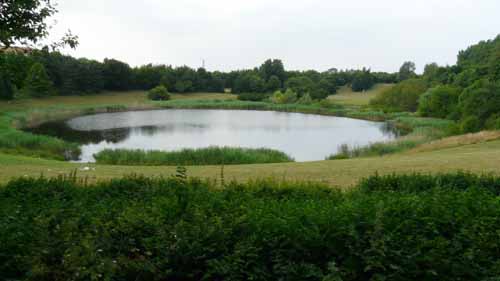
23. An overall view of the park, with the Politiken cut-off in the back, on the right.
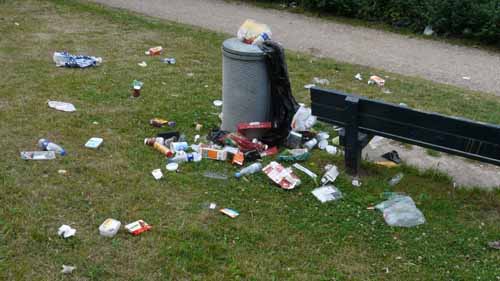
24. Park bench at the top of the park, near the busy road of Sønder Ringsvej. It’s obvious where festival goers had been recreating. Mind you, that was the only mess we saw in two weeks of Denmark. Ah, those foreigners...
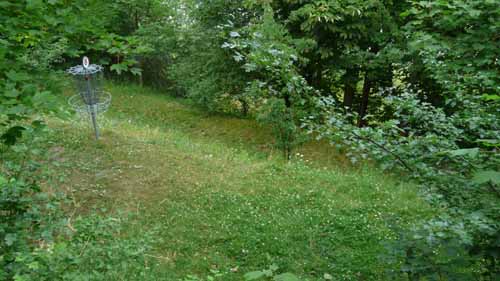
25. You can still see the theatre-shaped steps on the slope down towards Pirelli corner.
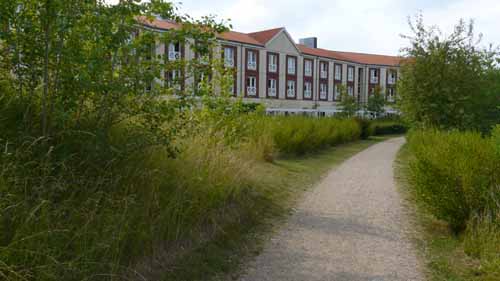
26. The footpath back towards the hotel.
And that’s not all. There is an excellent exhibition on the Roskilde Ring at the Roskilde Museum, situated just behind Roskilde cathedral in the center of town. And if you really want to experience the Ring first-hand… a excellent track simulation was created for the Grand Prix Legends game some years ago. So enjoy!
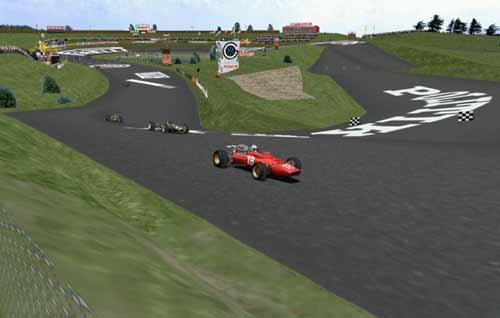
A screenshot of Roskilde Ring's GPL rendition, seen from Politiken.
